|
|
|
|
|
English
|
Japanese
|
Chinese
|
Sanskrit / Pali
|
Korean
|
Tibetan
|
|
One of Love;
resides in Tusita
paradise but will
return to earth as
Buddha of Future
|
Miroku 弥勒
Another name
is Jishi 慈氏
|
Mílè 彌勒
Mile (Mi-le)
Mílèpúsà 彌勒菩薩
Mileh-fo, Mi Lo Fwo
|
Maitreya
मैत्रेय
(name means
lovingly kind)
|
Mireuk
Mirŭk
미륵
|
Cham pa
Byama-pa
Namdren Mapham
Jampa ("Friend")
|
|

|
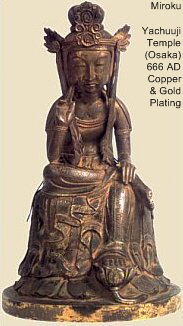
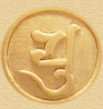
Sanskrit Seed for Miroku
(Pronounced “YU” in Japan
|
|
 
Miroku Nyorai, Miroku Bosatsu
Buddha of the Future, Bodhisattva of the Present
Also known as Miroku Butsu 弥勒仏 (Miroku Buddha), or
Miraibutsu 未来仏 or Shōraibutsu 将来仏 (lit. Future Buddha).
- Depicted as either a Buddha or Bodhisattva
- Lord of Tuṣita Heaven 兜率天 (Jp = Tosotsu Ten; see below)
- Worshipped by both Mahayana & Therevada followers
- Profound Korean Influence on Japan’s Miroku statuary
- Hotei, one of Japan’s popular 7 Lucky Gods, is considered an incarnation of Miroku Bosatsu
- Also associated with Jizō Bosatsu, one of Japan’s most beloved deities, who vowed to remain on earth doing good deeds until the advent of Miroku in the distant future
ORIGIN = INDIA

On Maitareiya Sowaka (Mantra for Miroku in Japan)
Miroku is already prominent in Japan by the 7th century AD and was among the most important deities in early Japanese Buddhism. By the 9th century, Miroku became extremely popular among believers of the Shingon Sect, a form of Esoteric Buddhism (Mikkyō 密教). Founded by Kōbō Daishi (774 to 835 AD), who visited China and brought back the teachings, the Shingon sect believes that, far in the future, Miroku Bodhisattva will become a Buddha, and then appear on earth to save those unable to achieve enlightenment, thus bringing universal salvation to all sentient beings.
Even today, Shingon followers are awaiting Miroku's return, scheduled to occur 5.6 billion years after the death of the Historical Buddha (his death is generally given in modern times as 483 BC but a date still contested by scholars). Miroku is also one of the 13 Buddha 十三仏 (Jūsanbutsu) of Japan’s Shingon Sect of Esoteric Buddhism. In this role, Miroku presides over the memorial service held on the 42nd day following one's death. Among Japan’s Esoteric sects, Miroku likewise appears in the Kongōkai Mandala as one of the 16 Deities of the Auspicious Aeon, and in the Eight-Petal Court of the Taizōkai Mandala, where Miroku’s right hand is often shown holding a lotus surmounted with a vase and Miroku’s left hand forming the fear not mudra. There is also a mandala devoted to Miroku called the Miroku Mandala.

 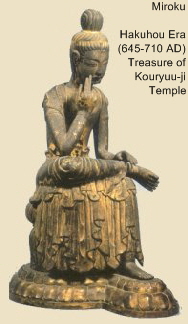  Buddha of the Future Buddha of the Future
In the latter half of Japan’s Heian period (794-1185) there arose a widespread belief in the “Three Periods of Law” -- a concept of society’s rise and fall that originated much earlier in Indian Buddhism but came to prominence later in China and then Japan. It foretold of the world’s ultimate decay and the complete disappearance of Buddhist practice. The Japanese believed the third and final period -- the Age of Mappō (Decline of the Law; see below) -- had begun in 1052. The ensuing decades, moreover, were marked by civil wars, famine, and pestilence. A sense of foreboding filled the land, and people from all classes yearned for a gospel of salvation. Faith in Miroku experienced a revival during this time, but Miroku faith was ultimately overshadowed by the teachings of the Pure Land sects (Jōdokyō 浄土教) devoted to Amida Buddha. Nevertheless, Miroku became intimately linked to ideas concerning the Three Periods of Law, and like Amida, artwork portrayed Miroku descending to earth to welcome and then convey devotees to Miroku’s Tusita 兜率天 heaven. Such pieces are known as Miroku Raigō-zu 弥勒来迎図 (lit. = Miroku’s Welcoming Descent).
Days of Dharma, Three Periods of Law
In Buddhist lore, the Days of the Dharma (Buddhist Law) are divided into three periods, called the Three Periods of Law (Jp. = 三時 Sanji, literally “three periods;” or Shōzōmatsu 正像末 (literally “true, semblance, and degenerate”). There are various schemes used to represent the Days of the Dharma, with varying lengths for each period, but the below scheme is commonly recognized in Japan. It was a concept that resonated especially with Japan’s Pure Land school (Jōdo Shū 淨土宗). Below text gives the Japanese spellings.
- First Phase. True Law. The Age of Shōbō (Shobo) 正法, which lasts 1,000 years following the death of the Historical Buddha, whose death was generally given as 949 BC in the old calendar. The first phase symbolizes the Turning of the Wheel of the Law (a metaphor for teaching the way to enlightenment); the first phase refers to the spread and acceptance of Buddhist teachings; sometimes known as the “Age of Correct Law,” it was considered a golden age, when followers had the capacity to understand and practice the Buddhist teachings. Other translations include “Age of True Teaching” or “Age of Correct Dharma.”
- Second Phase. Copied Law. The Age of Zōhō (Zoho) 像法, which lasts 1,000 years; during this period the practice of the Law begins to deteriorate. Also translated as the “Age of Copied Law,” or the “Age of the Imitation Law,” or the “Age of Semblance Dharma,” or the “Age of Semblance Teaching.”
- Last Phase, Final Phase. Degenerate Law. The Age of Mappō (Mappo) 末法, which lasts 3,000 years; during this period, the practice of the Law declines until no one follows the Buddhist tenets; also translated as the “Age of the Decline of the Law,” or the “Age of Degenerate Dharma,” or the “Age of Degenerate Teaching.”
NOTE: Says scholar Robert E. Morrell, in his wonderful book “Kamakura Buddhism, A Minority Report:” Asian Humanities Press, Berkeley, California, 1987; ISBN 0-89581-849-3:
“In China, the Period of the True Law (first phase) was generally understood to have been the interval of 500 years after the death of the Historical Buddha, during which his followers had the capacity both to understand and to practice the Dharma. According to the calculations of the time, the Buddha left this life in the year 949 BC of the Western calendar, so this first period would have continued through 449 BC. The thousand-year Period of the Imitation Law (second phase), during which there would be understanding of the teaching but deteriorating practice, would then continue through 551 AD (since the year 1 AD immediately follows 1 BC). The year 552 AD would then be the first of 10,000 years (although the most common schemes use a 500/1000 pattern) constituting the Period of the Decline of the Law (last phase), during which both understanding and practice would disappear. The chief proponent of this view in China was Hsin-hsing (Jp. = Shingyō, 540-594 AD). His Sect of the Three Stages (Jp. = Sangaikyō) was short-lived, but provides an instructive parallel to later Japanese developments.” <Morrell also asks in his footnotes: “Is it mere coincidence that the Chronicles of Japan (Nihon Shoki, 720 AD) gives 552 AD as the year of the first official introduction of Buddhism to Japan?>


|
Buddha of Three Worlds
(Jp. = Sanze Butsu)
Jizo Bosatsu promised to remain in this world until the advent of Miroku Buddha
|
|
 Tusita 兜率天 Pure Land Tusita 兜率天 Pure Land
Lord of Tuṣita Heaven 兜率天 (Jp. = Tosotsu Ten). Regardless of the scheme used, in the very last period, Buddhism will weaken and fade, but a new Buddha will then appear to once again "turn the wheel of the law" and bring universal salvation to all sentient beings. This Future Buddha is Maitreya (Miroku). Technically speaking, Miroku is a Bodhisattva who resides in the Tusita 兜率天 heaven -- the place where Bodhisattva dwell before incarnation -- but Miroku is still considered a Buddha in light of Miroku's impending arrival. This explains why Miroku can be represented as either a Bodhisattva or Buddha. Nonetheless, it is rather unclear why Japan's Shingon Sect believes Miroku Buddha will appear 5.6 billion years following the death of the Historical Buddha. According to the timeframe set forth in the Days of the Dharma, isn't that supposed to be around 4000 AD?

 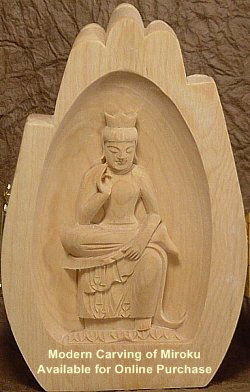  Miroku Artwork in Japan Miroku Artwork in Japan
From the late Heian period onward, the majority of Miroku artwork in Japan depicts Miroku as a Bodhisattva -- not sure if this holds true outside Japan -- holding a stupa (tō 塔) or wearing a stupa in the crown. Also, in Japan, Miroku is typically shown seated, with the finger of the right hand touching the cheek, as if in deep meditation or musing, and the ankle of the right foot resting atop the left knee (Hankazō 半跏像 or Hanka Shiyuizō 半跏思惟像). The left hand is typically shown resting on the ankle of the right foot. These are characteristic of Miroku statuary -- indeed, the half-lotus sitting position and cheek-touching gesture are rarely found on other Buddha and Bodhisattva statues. Sometimes Miroku's hands form the Fear Not Mudra and Charity Mudra, much like the Historical Buddha, for Miroku is the future heir to the Buddha of the Present, who is none other than Shaka Buddha (the Historical Buddha). Since Miroku will return as the Buddha of the Future, statues of Miroku are not generally portrayed with the ornaments, princely clothing, and headdresses found on most Bodhisattva statues. Rather, Miroku Bodhisattva is generally portrayed in a form more akin to a Buddha (i.e., simple clothing, unadorned, without an elaborate headdress). To help you differentiate between the Nyorai (Buddha) and Bosatsu (Bodhisattva) versions of Miroku, just remember that Bosatsu statues are typically ornate, wearing crowns, jewelry, and princely clothes. In contrast, statues of the Nyorai (Buddha) are typically unadorned and dressed in the simple robe of a monk. This guideline doesn’t always work, of course, but in often yields a correct assessment of the deity. Finally, we should note that Korea’s influence on Japan’s Miroku statuary was profound.


|
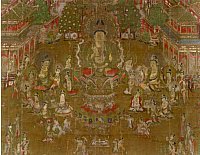
|
|
Tosotsuten Mandala 兜率天曼荼羅
Shiga Prefecture, Important Prefectural Property, Color on Silk; no date given at this J-site (where image was found).
Such mandala began appearing in the Kamakura period, and depicted Miroku in Tusita Heaven.
|
|
 Miroku Mandala 弥勒曼荼羅 Miroku Mandala 弥勒曼荼羅
Also known as the Miroku Bosatsu Mandara 弥勒菩薩曼荼羅. Classified as a Besson Mandala, one featuring a single deity from the Bodhisattva Family, in this case Miroku 弥勒, the Future Buddha. Extant examples of this mandala from the Kamakura period are preserved at Daigoji Temple 醍醐寺 (Kyoto) and at Reiunji Temple 霊雲寺 (Tokyo).
In Esoteric Buddhism, Miroku appears in the Eight-Petal Court of the Taizōkai Mandala, and in the Kongōkai Mandala as one of the 16 Deities of the Auspicious Aeon (Gengō Jūrokuson 賢劫十六尊). A 30-armed form of Miroku is also mentioned in iconographic texts, but no statuary or mandala of this type exists. Miroku also appears in the Tosotsuten Mandala 兜率天曼荼羅 depicting Miroku’s Tusita Heaven (one is preserved at Enmeiji 延命寺 in Osaka), as well as in paintings known as the Miroku Raigō-zu 弥勒来迎図 (one is preserved at Shōmyōji Temple 称名寺 in Kanagawa prefecture). The latter shows Miroku’s descent to earth to bring devotees back to Miroku’s Pure Land (akin to Amida Raigo artwork).

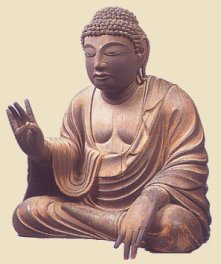
Miroku Nyorai, 9th Century, Todai-ji, Nara
Photo Courtesy of book entitled
The Concise History of Japanese Buddhist Sculpture (page 071)
Bijutsu Shuppan-Sha, ISBN 4-568-40061-9
http://www.bijutsu.co.jp
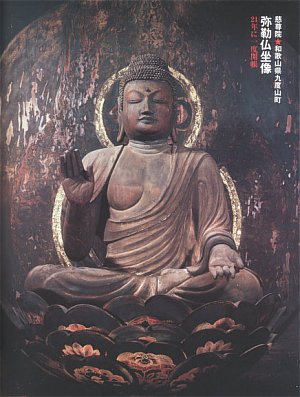
Miroku Nyorai, Jison-in, Wakayama Pref., Heian Era
Photo Courtesy of book Hidden Buddhas of Japan (page 78)
Corona Books, ISBN 4-582-63395-1
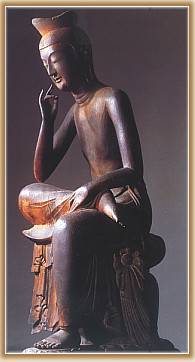
Miroku Bosatsu, 7th Century, Kyoto, National Treasure
Kouryuu-ji Temple, Wood, H = 84.2 cm
Photo Courtesy of book entitled
Concise History of Japanese Buddhist Sculpture (page 015)
Bijutsu Shuppan-Sha, ISBN 4-568-40061-9
http://www.bijutsu.co.jp

BELOW TEXT COURTESY SHINGON.ORG
There are many different forms or images of the Maitreya (Miroku), yet many of these forms of Maitreya show a stupa in the crown. This contains a sarira or real relic of the Buddha Sakyamuni. In the Shingon Tradition, it is taught that this stupa represents Mahavairocana (Dainichi) Buddha.
Maitreya Bodhisattva is the Buddha who saves the world of the future. Sakyamuni was born in this world 2,500 years ago and preached the teachings of salvation for all humanity. After the passage of 5,670,000,000 years into the future after the death of Sakyamuni , Maitreya Bodhisattva will appear in the world and save all beings who have lost their way. At that time, a flower known as the Dragon Blossom will bloom, and Maitreya Bodhisattva will convene a gathering three times to preach the teachings and save the world. This is referred to as the Three Gatherings of the Dragon Blossom.
Another name for Maitreya Bodhisattva is Jishi Bodhisattva 慈氏, the Bodhisattva of Compassion, and this is because he vowed to save all beings in the world with a mind of compassion.
Kobo Daishi (774 to 835 AD), the real-life founder of the Japanese Shingon sect of Esoteric Buddhism, resides in the Tusita Heaven, which is the pure land of Maitreya Bodhisattva, and he guarantees Maitreya's vow, having attained salvation in this present world. It is for this reason that Kobo Daishi is said to grant salvation during the time between the death of Sakyamuni and the appearance of Maitreya, and is a source of great spiritual light as the Bodhisattva between these two Buddhist deities.
Editor’s Note: In some traditions, Jizo Bosatsu was entrusted by the Historical Buddha to save others between the time of the Buddha's death and the arrival of Miroku. But according to this Shingon web site, Kobo Daishi has taken over this task from Jizo.

MORE PHOTOS OF MIROKU
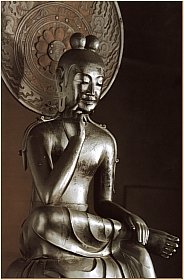 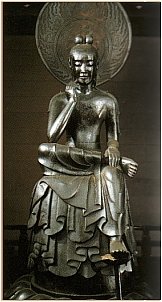
Miroku Bosatsu (Two views of same statue)
7th Century AD, Wood, Chuuguuji Temple 中宮寺 (Nara)
87 cm in height, Made of Japanese Cinnamon Wood
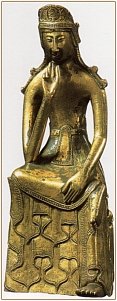 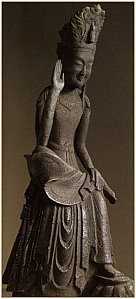 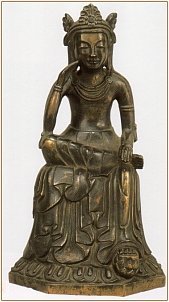
Miroku Bosatsu (All copper with gold plating)
(L) Three Kingdoms Era, 6th - 7th Century AD
Houryuu-ji Temple, 20.4 cm in height
(M) 7th Century, Kanmatsu-in Temple, 16.4 cm in height
(R) 7th Century AD, Houryuu-ji Temple, 23.6 cm in height
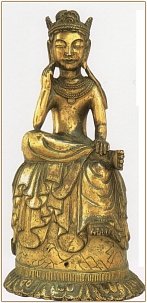 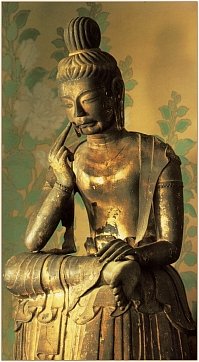
(L) Miroku Bosatsu, 7th Century AD
Houryuu-ji Temple, Copper with Gold Plating, H = 22 cm
(R) Miroku Bosatsu, Early 7th C. AD
Wood, Kouryuu-ji Temple, H = 66.4 cm
|
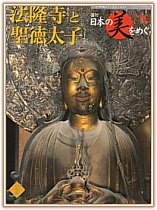
|
ABOVE SEVEN PHOTOS COURTESY:
Exploring the Beauty of Japan #11
July 9th, 2002
40+ pages, 70+ color photos
Japanese Language Only
Publisher: 小学館、東京都千代田区
一ツ橋 2-3-1, TEL: 03-3230-5118
Wonderful magazine featuring treasures of Houryuu-ji Templei. Some photos at this site were scanned from this magazine.
|
|

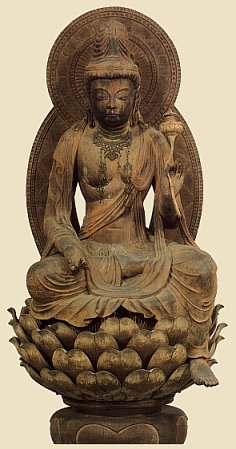
Miroku Bosatsu, Wood with Pigment
Located inside the Sangyou-in at Houryuu-ji Temple
Heian Era, 9th Century, H = 97 cm
Above Photo Courtesy: Showa Inventory of Houryuu-ji Temple, Page 62
Exhibition of the Treasures of Houryuu-ji Temple. 法隆寺昭和資財帳調査完成記念 - 国宝法隆寺展.
Exhibition Catalog, 1994. Exhibition held in turn at the Nara National Museum and
Tokyo National Museum, and then the Fukuoka, Nagoya, and Sendai Municipal Museums.

LEARN MORE
- Buddhist-Artwork.com. Miroku statues are available for online purchase at our sister site.

- Korean Influence on Japan’s Miroku Statuary (this site)
- Butsuzō-zu-i 仏像図彙, the “Collected Illustrations of Buddhist Images.” Published in 1690 (Genroku 元禄 3). One of Japan’s first major studies of Buddhist iconography. Hundreds of pages and drawings, with deities classified into approximately 80 (eighty) categories. Modern-day reprints are available at this online store (J-site).
- Mandara Zuten 曼荼羅図典 (Japanese Edition). The Mandala Dictionary. 422 pages. First published in 1993. Publisher Daihorinkaku 大法輪閣. Language Japanese. ISBN-10: 480461102-9. Available at Amazon.
- JAANUS. aisf.or.jp/~jaanus/deta/m/miroku.htm
- The Statue of Miroku Bosatsu of Chūgūji. By Sherwood F. Moran.
- Hotei, the “laughing Buddha,” one of Japan’s Seven Lucky Gods.
Said to be an incarnation of Miroku Bosatsu
- www.shingon.org
- Handbook on Viewing Buddhist Statues. A totally wonderful book, by Ishii Ayako. The 2nd image shown on this site page was scanned from this book; Japanese language only; 192 pages; 80 or so color photos. Click here to buy book at Amazon.
|
半跏思惟像 (はんかしゆいぞう)の弥勒菩薩が有名です 。五仏の付いている冠をかぶったり、手に宝塔を持っている姿が一般的です。お釈迦様が亡くなってから56億7000万年後に現れると言われている。
|
|

|
|